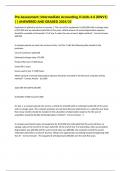Pre-Assessment: Intermediate Accounting II Units 4-6 (KWV1)
|| ANSWERED AND GRADED 2024/25
Equipment is placed in service on January 1. The cost of the equipment is $250,000 with a salvage value
of $25,000 and an estimated useful life of five years. Which amount of annual depreciation expense
should be recorded on December 31 of Year 2 under the sum-of-years'-digits method? - Correct Answer
$60,000
A company placed an asset into service on Day 1 of Year 1 with the following data related to the
purchase:
Cost of machinery $225,000
Estimated salvage value $75,000
Product life hours 75,000 hours
Useful life 5 years
Hours used in Year 1 5,000 hours
Which amount of annual depreciation expense should be recorded in the first year using the activity
method? - Correct Answer $10,000
$225,000-$75,000=$150,000
($150,000*5,000 hours)/75,000
On July 1, a company placed into service a vehicle for $50,000 with an estimated useful life of five years
and no salvage value. The company prepares accrual-basis financial statements on a calendar-year basis.
How many months should be included in the calculation of depreciation expense for the year of
acquisition using the double-declining-balance method? - Correct Answer 6
A company purchased a piece of equipment for $120,000 and estimated that the asset will have no
salvage value at the end of its 15-year useful life. At the end of Year 5 of ownership, when accumulated
depreciation was $40,000 and the asset's book value was $80,000, the company revised the asset's
estimated useful life to a total of 10 years. What is the appropriate accounting treatment beginning with
Year 6? - Correct Answer The equipment will depreciate $80,000 over the next five years.
, A company using the composite approach to depreciation sells equipment for $10,000. The equipment
was purchased five years earlier for $15,000, and the company has already recorded $5,000 in
accumulated depreciation. What is included in the journal entry for the sale of the equipment? - Correct
Answer Debit accumulated depreciation-equipment for $5,000
A steel manufacturer uses the production variable method for depreciating assets. Which combination
best describes the depreciation method used? - Correct Answer Straight-line and activity
A company owns an asset with an original cost of $300,000 and a current book value of $160,000. During
a review of the asset for impairment, the company estimates the expected future cash flows from the
use and disposal of the asset to be $200,000. There is an active market for this asset, and the fair value
of the asset, calculated as the present value of expected future cash flows, is $140,000. Should this asset
be considered impaired? - Correct Answer No, because the estimate of expected future cash flows
(undiscounted) is greater than the book value.
Several years ago, a company acquired an asset at a cost of $400,000. Last year, the company recognized
an impairment loss of $25,000 and properly reduced the asset's book value from $250,000 to $225,000.
Using the asset's new base of $225,000, the company calculates depreciation for the current year to be
$10,000, bringing the book value down to $215,000. However, the company has also determined that
the asset's fair value has recovered and is now estimated to be $260,000.
How should the company measure the asset on its current balance sheet - Correct Answer The
company should not reverse the impairment and should depreciate the asset by $10,000 to a new book
value of $215,000.
A company invests $15,000,000 into a coal mine estimated to have 20 million tons of coal. The coal mine
is estimated to be in operation for the next five years. In Year 1, the company extracted and sold 1
million tons of coal. How much is depletion in Year 1? - Correct Answer $750,000
$15,000,000/20,000,000= $.75
$.75*1,000,000=$750,000




